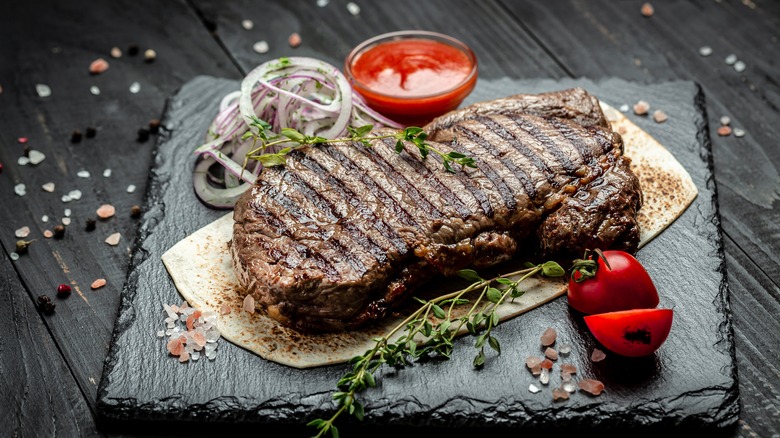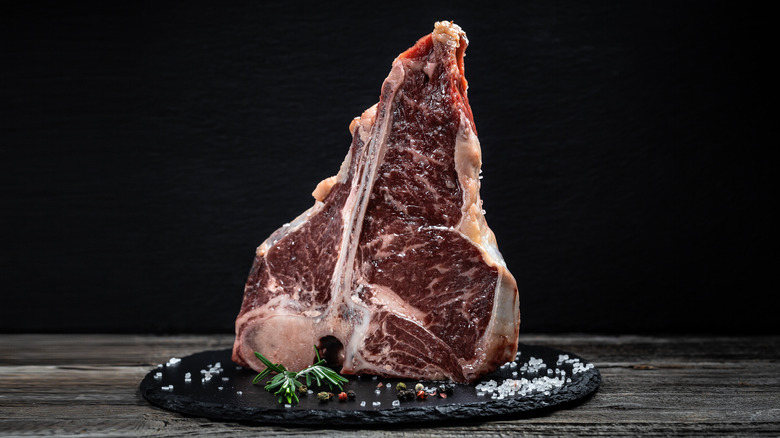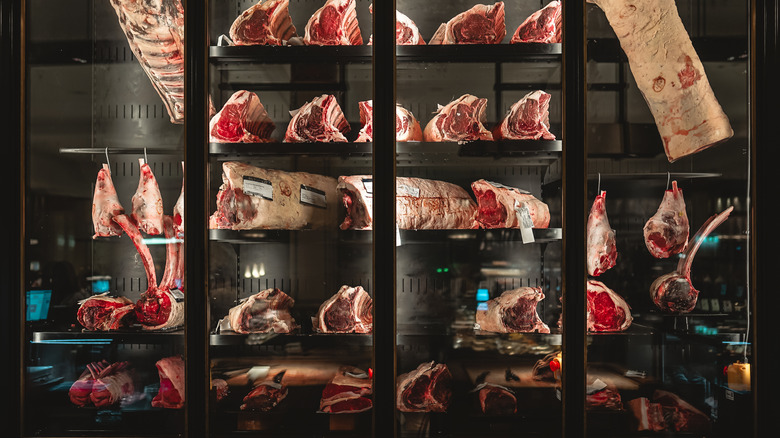The Reason Dry-Aged Steak Is More Expensive Than Regular Steak
If you frequent butcher shops and the best steak houses, you no doubt have come across dry-aged steaks before — and their rather hefty price tags. Wondering why the process to help this cut of meat develop flavor and make it more tender costs so much? Then you've come to the right place.
Believe it or not, it's not a case of butchers or restauranteurs trying to make a few extra bucks. Instead, dry-aged steaks demand a premium price for a few good reasons, not the least of which is the simple fact they are delicious. If you've tried one, you know the truth of this statement. If not, do yourself a favor and pony up for one; you won't regret it.
Indeed, they have a depth of flavor that can only be achieved through the dry-aging process. Take note, though, as they're not for everyone. Just as some people don't care for aged cheese, many also find dry-aged steaks a little stout for their taste.
What is dry-aged beef?
In the video "Science of Dry Aging" by George Motz, Dr. Phil Bass explains that dry-aged beef is created by placing whole cuts of meat in a controlled environment (via YouTube). The goal is to keep the muscle tissue at a temperature and humidity level that allows moister to migrate out of the meat at a proper rate.
At the same time the meat is losing moister, enzymes, which are naturally in the muscle, begin to break down the connective tissue, making the beef more tender. Working with the enzymes are molds and yeast that help further tenderize the meat and transform its flavor.
While this may sound a bit unsavory, the molds and yeast that are hard at work creating a dry-aged steak are entirely safe. In fact, cheese makers and brewers use these same microbes to make blue cheese, beer, and other culinary delicacies. The end result of this process is a piece of beef that's denser, more tender, and has a very unique flavor profile.
In the same video, food writer Nick Solares describes the difference between dry-aged and wet-aged beef as similar to that of grape juice and wine. Of course, they come from the same source but only one is fermented. Indeed, wine and dry-aged steak just hit different.
Why does dry-aged steak cost more?
Dry-aged steaks also cost more than regular cuts because they take more time to produce. A 30-day-aged piece of beef takes 30 days to deliver. By comparison, a 90-day-aged cut takes three times longer. As we learned in the video by George Motz on YouTube, butchers must store it in a controlled environment for this entire period. And of course, refrigeration units cost money to run and are an added expense.
You also have to factor in shrinkage. Remember, the meat loses moisture while aging. According to Straits Research, it can shrink by up to 30% during this process. This is extreme, but consider butchers may pay for a 10-pound strip loin and end up with only 7 pounds of saleable beef. They then must try to recoup the loin's original cost before seeing any profit. In other words, consumers wind up paying more.
Lastly, per the video, the meat's outer layer, with its microbial growth, gets trimmed away before being cut into steaks. This creates more waste and added expense for the meat master. If you tally all these factors, it becomes easy to see why dry-aged steaks cost more than wet-aged or unaged beef.


